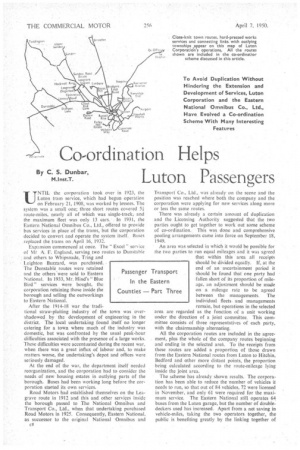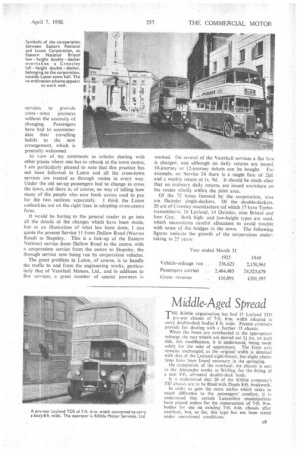VVIiTos n a d e Co-ordination Helps
Page 44

Page 45

If you've noticed an error in this article please click here to report it so we can fix it.
Luton Passengers
By C. S. Dunbar, m.inst.T.
NTIL the corporation took over in 1923, the
I T
Luton tram service, which had begun operation
on February 21, 1908, was worked by lessees. The system was a small one; three short routes covered 51 route-miles, nearly all of which was single-track; and the maximum fleet was only 13 cars. In 1931, the Eastern National Omnibus Co., Ltd., offered to provide bus services in place of the trams, but the corporation decided to convert and operate the system itself. Buses
• replaced the trams on April 16, 1932.
Expansion commenced at once. The " Excel " service of Mr A. F. England, serving. two routes to Dunstable and others to Whipsnade, Tring and Leighton Buzzard, was purchased. The Dunstable, routes were retained and the others were sold to Eastern National. In 1933, Mr. Hind's" Blue Bird" services were bought, the corporation retaining those inside the borough and selling the outworkings to Eastern National.
After the 1914-18 war the traditional straw-plaiting industry of the town was overshadowed by the development of engineering in the district. The local undertaking found itself no longer catering for a town where much of the industry was domestic, but was confronted by the usual peak-hour difficulties associated with the presence of a large works. These difficulties were accentuated during the recent war, when there was a great influx of labour and, to make matters worse, the undertaking's depot and offices were seriously damaged.
At the end of the war, the department itself needed reorganization, and the corporation had to consider the needs of new housing estates in outlying parts of the borough. Buses had been working long before the corporation started its own services.
Road Motors had established themselves on the Leagrave route in 1912 and this and other services inside the borough passed to The National Omnibus and Transport Co., Ltd., when that undertaking purchased Road Motors in 1925. Consequently, Eastern National, as successor to the original National Omnibus and cS Transport Co., Ltd., was already on the scene and the position was reached where both the company and the corporation were applying for new services along more or less the same routes.
There was already a certain amount of duplication • and the Licensing Authority suggested that the two parties ought to get together to work out some scheme of co-ordination. This was done and comprehensive pooling arrangements came into force on September 18, 1949.
An area was selected in which it would be possible for the two parties to run equal mileages and it was agreed that within this area all receipts should be divided equally. If, at the end of an ascertainment period it should be found that one party had fallen short of its proportion of mileage, an adjustment should be made on a mileage rate to be agreed between the managements. The individual fleets and managements remain, but operations in the selected area are regarded as the function of a unit working under the direction of a joint committee. This committee consists of three representatives of each party, with the chairmanship alternating.
All the corporation routes are included in the agreement, plus the whole of the company routes beginning and ending in the selected area. To the receipts from these routes are added a proportion of those drawn from the Eastern National routes from Luton to Hitchin, Bedford and other more distant points, the proportion being calculated according to the route-mileage lying inside the joint area.
The scheme has already shown results. The corporation has been able to reduce the number of vehicles it needs to run, so that out of 84 vehicles, 72 were licensed in November, and only 61 were required for the maximum service. The Eastern National still operates 64 buses from the Luton garage, but the number of doubledeckers used has increased. Apart from a net saving in vehicle-miles, 'taking the two operators together, the public is benefiting greatly by the linking together of
services to provide
cross town journeys
without the necessity of changing. Passengers have had to accommodate their travelling habits to the new arrangement, which is generally welcomed.
In view of my comments in articles dealing with other places where one has to rebook at the town centre, am particularly pleased to note that this practice has not been followed in Luton and all the cross-town services are treated as through routes in every way. Under the old set-up passengers had to change to cross the town, and there is, of course, no way of telling how many of the people who now book across used to pay for the two sections separately. I think the Luton authorities are on the right lines in adopting cross-centre fares.
It would be boring to the general reader to go into all the details of the changes which have been made, but as an illustration of what has been done, I can quote the present Service 11 from Dallow Road (Warren Road) to Stopsley. This is a link-up of the Eastern National service from Dallow Road to the centre, with a corporation service from the centre to Stopsley, the through service now being run by corporation vehicles.
The great problem in Luton, of course, is to handle the traffic to and from the engineering works, particularly that of Vauxhall Motors, Ltd., and in addition to five services, a great number of special journeys is worked. On several of the Vauxhall services a fiat fare is charged, and although no daily returns are issued, 10-journey or 12-journey tickets can be bought. For example, on Service 24 there is a single fare of 21-cl. and a weekly return at Is. 9d. It should be made clear that no ordinary daily returns are issued anywhere on the routes wholly within the joint area.
Of the 72 buses licensed by the corporation, nine are Daimler single-deckers. Of the double-deckers, 20 are of Crossley manufacture (of which 17 have Turbotransmitters), 16 Leyland, 14 Daimler, nine Bristol and four Guy. Both highand low-height types are used, which necessitates careful allocahon to avoid trouble with some of the bridges in the town. The following figures indicate the growth of the corporation undertaking in 25 ears.
































































































